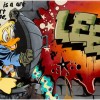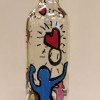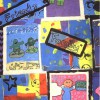- Keith Haring Murals in San Sebastián
- Keith Haring Murals
- Come To Know Keith Haring
- Organ Systems Mural
- City as Canvas: Artist Spotlight
- Printing with Objects
- Mural Making in the Style Of Keith Haring
- Subway Graffiti Project
- T-shirt Designer
- Keith Haring Semiotics Poster
- Introducing Keith Haring
- Discovering Keith Haring
- Haring Inspired Mural
- All Bottled Up!
- Thinking about Drawings as Symbols
Curriculum | Art Criticism
City as Canvas: Artist Spotlight

This guide is intended to be used as a resource for teachers either preparing to visit the Museum of the City of New York’s City as Canvas: Graffiti Art from the Martin Wong Collection or to use in the classroom following a class visit.
During the gallery tour of the City As Canvas exhibition, students will view highlights from the Museum's rich collection of 1970s and '80s graffiti art in New York. By analyzing the drawings, paintings, photographs and blackbooks collected by Martin Wong, students will learn about New York City artists known as “writers”, like Keith Haring, Lady Pink, Lee Quiñones, and Daze, and the historical context in which their work was created. Students will be able to elaborate on the multiple perspectives surrounding street art, discuss the various styles represented, and will respond creatively to the pieces by drafting their own sketches.
The information and activities in this guide correlate to the guided tour, but may also be taught as stand-alone lessons utilizing the text, images, and suggested activities. Teachers are encouraged to adapt the information to the grade level and ability of their students. For further information or to schedule a visit to the Museum of the City of New York, please email the Frederick A.O. Schwarz Children’s Center at schoolprograms@mcny.org
Creation and Expression
Reflecting on Text and Context in Art
What does art tell us about the time and place of its creation, and what does the context tell us about an artwork? In this lesson, students consider the work of Keith Haring in the late 1970s and early 1980s, which can be used as a framework for studying any artist and era. Students research historically and culturally significant events as a potential means to understand artists and their works. They create and present slide shows that incorporate images of the work with commentary that place the pieces in their historical and cultural context. Finally, they trace the legacy of their chosen artist via the work of artists who came later or their effect on culture.
A Sculptor’s Model

This lesson was designed to parallel The Tampa Museum's survey: "Keith Haring: Art & Commerce," on view March 18 through June 11, 2006.
Local children were presented with a slide presentation of Haring's work, with a particular emphasis on Haring's large scale steel sculptures and accompanying sculptural macquettes. Students then participated in a workshop where they too could design and construct their own scaled down models of imaginary, mythic sculptures.
Teaching to Standards
A joint effort between the University of Arizona's Education division and a local public school summer program, this lesson explores how some Apache students responded to Keith Haring's art using their computers as art-making tools.
Across Curriculum
A wonderful lesson sent in by a school in England that helps students examine and discuss art while developing their own fun and silly essays.



